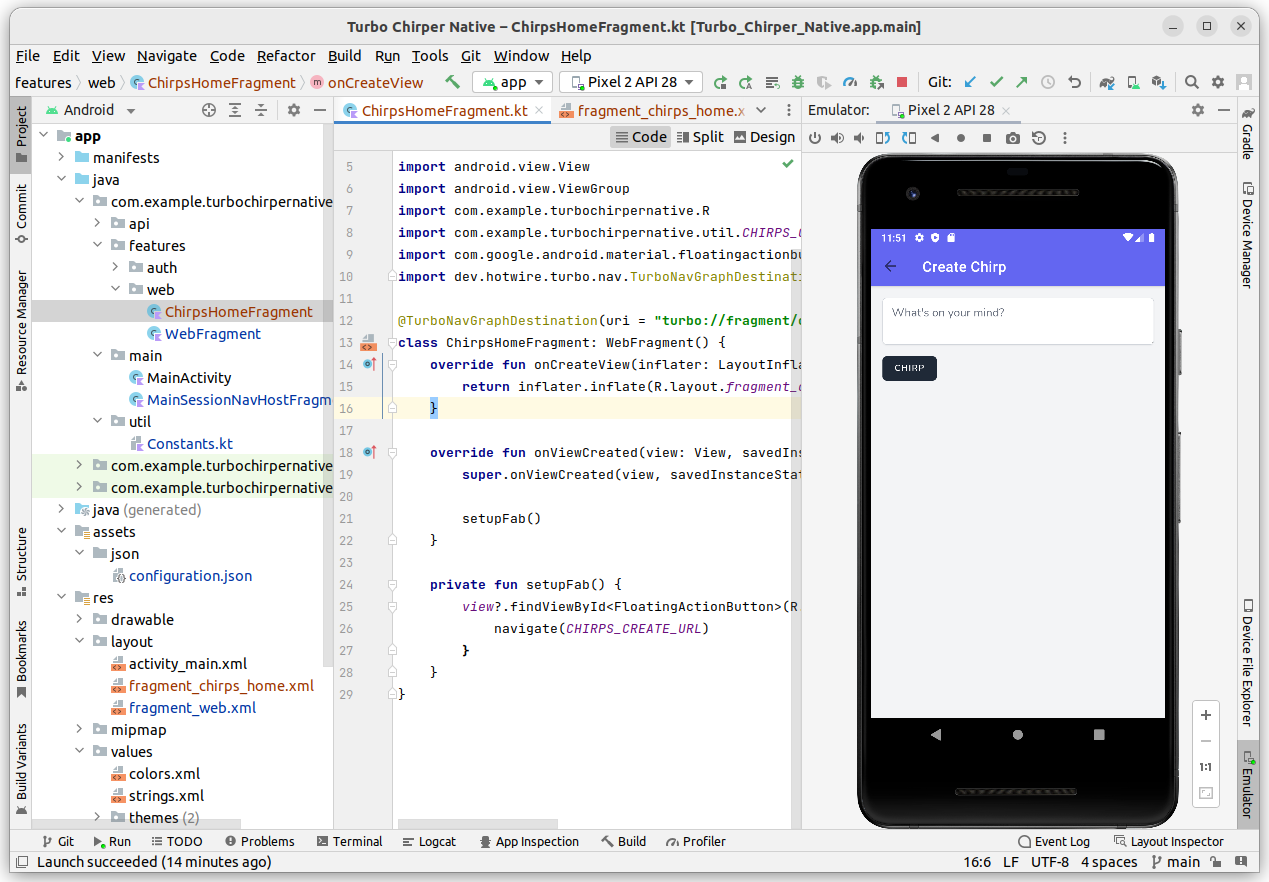10. Native Floating Action Button to Create Chirps
Introduction
Rendering the create chirps form inline right on the homepage isn't the best UX for mobile. Instead, it would be better to display the form as a native modal screen. Let's implement that, but first, let's hide the entire create chirps form on Turbo Native.
Hiding the Elements for Turbo Native only
We could technically prevent the entire section from even rendering on requests made by Turbo Native clients using the @unlessturbonative Blade directives, something like this:
<x-app-layout> <x-slot name="header"> <h2 class="font-semibold text-xl text-gray-800 leading-tight"> {{ __('Chirps') }} </h2> </x-slot> <div class="max-w-2xl mx-auto p-4 sm:p-6 lg:p-8"> @unlessturbonative <x-turbo::frame id="create_chirp" src="{{ route('chirps.create') }}"> <div class="relative flex items-center justify-center py-10 px-4 rounded-lg border border-dotted border-gray-300"> <a class="text-gray-700" href="{{ route('chirps.create') }}"> Add a new Chirp <span class="absolute inset-0"></span> </a> </div> </x-turbo::frame> @endunlessturbonative <div id="chirps" class="mt-6 bg-white shadow-sm rounded-lg divide-y"> @each('chirps._chirp', $chirps, 'chirp') </div> </div></x-app-layout>This would work, but that makes this page harder to cache. Not a problem now, but I prefer doing things like that on the client-side with CSS and a bit of JS.
Since we have configured our WebView to use a custom User-Agent header, we can actually detect when our webapp is running inside a Turbo Native client by checking that. Let's first add a helper to check the platform by creating a resources/js/helpers/platform.js file with the following contents:
const { userAgent } = window.navigator; export const isIos = /iPhone|iPad/.test(userAgent)export const isAndroid = /Android/.test(userAgent)export const isMobile = isIos || isAndroid export const isIosApp = /Turbo Native iOS/.test(userAgent)export const isAndroidApp = /Turbo Native Android/.test(userAgent)export const isMobileApp = isIosApp || isAndroidAppNow, let's update our resources/js/app.js file to add a turbo-native class to out HTML document:
import './bootstrap';import './elements/turbo-echo-stream-tag';import './libs';import '@github/time-elements';import { isMobileApp } from './helpers/platform'; if (isMobileApp) { document.documentElement.classList.add('turbo-native');} This will ensure that when our webapp runs inside a Turbo Native client, a .turbo-native class will be added to the <html> element in our page, but we're not doing anything yet with it. Let's create a custom TailwindCSS modifier that will allow us to make things behave differently when the .turbo-native class is present in the document.
To do that, open the tailwind.config.js file in the root of your Laravel app and make the following changes:
const defaultTheme = require('tailwindcss/defaultTheme');const plugin = require('tailwindcss/plugin'); /** @type {import('tailwindcss').Config} */module.exports = {
content: [ './vendor/laravel/framework/src/Illuminate/Pagination/resources/views/*.blade.php', './storage/framework/views/*.php', './resources/views/**/*.blade.php', ], theme: { extend: { fontFamily: { sans: ['Nunito', ...defaultTheme.fontFamily.sans], }, keyframes: { 'appear-then-fade': { '0%, 100%': { opacity: 0, }, '5%, 60%': { opacity: 1, }, } }, animation: { ['appear-then-fade']: 'appear-then-fade 4s ease-in-out both', }, }, }, plugins: [ require("@tailwindcss/forms"), plugin(function ({ addVariant }) { return addVariant('turbo-native', ['&.turbo-native', '.turbo-native &']); }), ],};With that, we can use the new modifier like any other default modifier in Tailwind. Let's use it to hide the create chirps form on the index page for Turbo Native clients. Open the resources/views/chirps/index.blade.php and make the following changes:
<x-app-layout>
<x-slot name="header"> <h2 class="font-semibold text-xl text-gray-800 leading-tight"> {{ __('Chirps') }} </h2> </x-slot> <div class="max-w-2xl mx-auto p-4 sm:p-6 lg:p-8"> <x-turbo::frame id="create_chirp" src="{{ route('chirps.create') }}"> <x-turbo::frame id="create_chirp" src="{{ route('chirps.create') }}" class="turbo-native:hidden" loading="lazy"> <div class="relative flex items-center justify-center py-10 px-4 rounded-lg border border-dotted border-gray-300"> <a class="text-gray-700" href="{{ route('chirps.create') }}"> Add a new Chirp <span class="absolute inset-0"></span> </a> </div> </x-turbo::frame> <div id="chirps" class="mt-6 bg-white shadow-sm rounded-lg divide-y"> @each('chirps._chirp', $chirps, 'chirp') </div> </div></x-app-layout>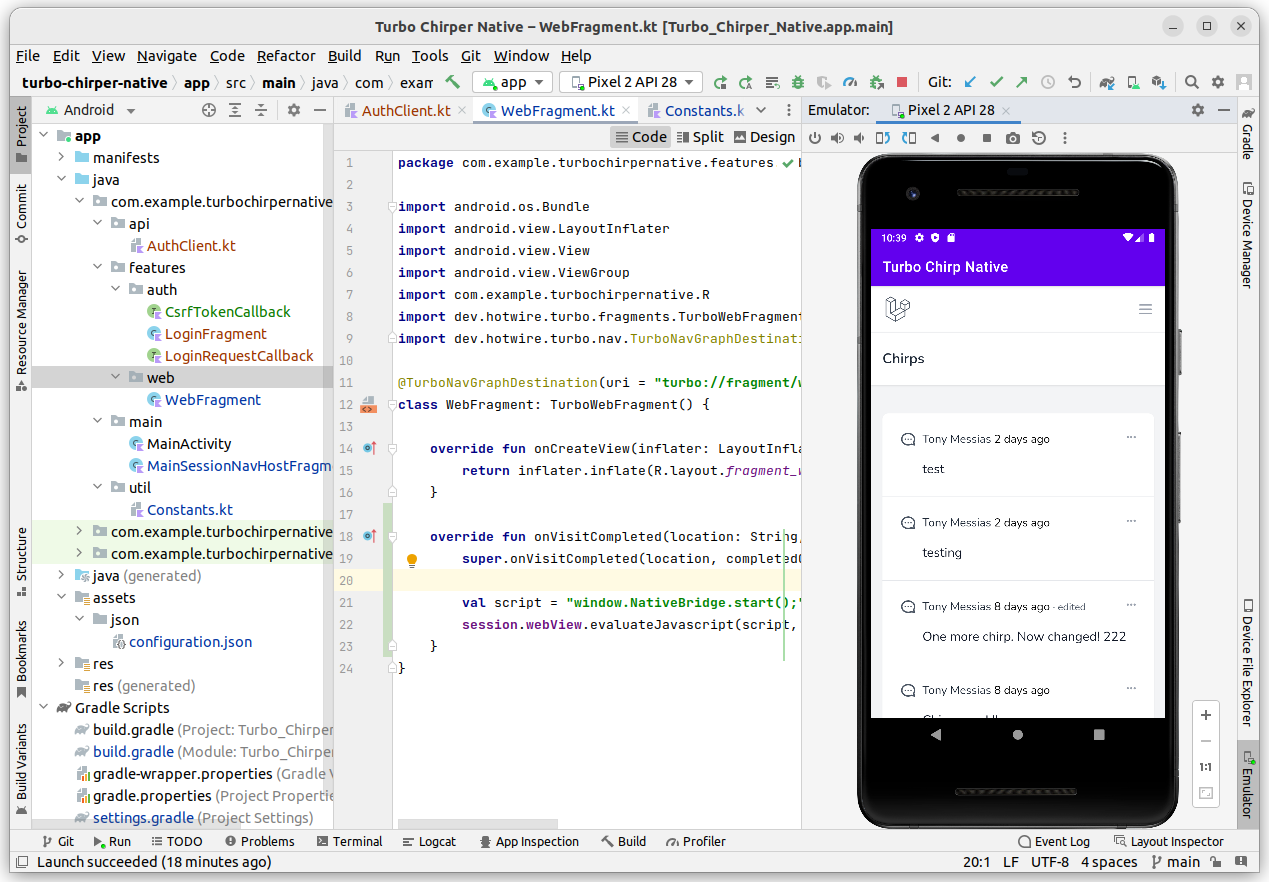
Let's also tweak our index page a bit to remove some padding and unnecessary margins:
<x-app-layout>
<x-slot name="header"> <h2 class="font-semibold text-xl text-gray-800 leading-tight"> {{ __('Chirps') }} </h2> </x-slot> <div class="max-w-2xl mx-auto p-4 sm:p-6 lg:p-8"> <div class="max-w-2xl mx-auto p-4 sm:p-6 lg:p-8 turbo-native:p-0"> <x-turbo::frame id="create_chirp" src="{{ route('chirps.create') }}" class="turbo-native:hidden" loading="lazy">
<div class="relative flex items-center justify-center py-10 px-4 rounded-lg border border-dotted border-gray-300"> <a class="text-gray-700" href="{{ route('chirps.create') }}"> Add a new Chirp <span class="absolute inset-0"></span> </a> </div> </x-turbo::frame> <div id="chirps" class="mt-6 bg-white shadow-sm rounded-lg divide-y"> <div id="chirps" class="mt-6 bg-white shadow-sm rounded-lg divide-y turbo-native:mt-0"> @each('chirps._chirp', $chirps, 'chirp') </div> </div></x-app-layout>Let's also hide the web nav bar for Turbo Native users, our navigation should be fully native on the mobile clients anyways. To do that, change the resources/views/layouts/navigation.blade.php file:
<nav x-data="{ open: false }" class="bg-white border-b border-gray-100"><nav x-data="{ open: false }" class="bg-white border-b border-gray-100 turbo-native:hidden">
<!-- Primary Navigation Menu --> <div class="max-w-7xl mx-auto px-4 sm:px-6 lg:px-8"> <div class="flex justify-between h-16"> <div class="flex"> <!-- Logo --> <div class="shrink-0 flex items-center"> <a href="{{ route('dashboard') }}"> <x-application-logo class="block h-10 w-auto fill-current text-gray-600" /> </a> </div> <!-- Navigation Links --> <div class="hidden space-x-8 sm:-my-px sm:ml-10 sm:flex"> <x-nav-link :href="route('dashboard')" :active="request()->routeIs('dashboard')"> {{ __('Dashboard') }} </x-nav-link> <x-nav-link :href="route('chirps.index')" :active="request()->routeIs('chirps.*')"> {{ __('Chirps') }} </x-nav-link> </div> </div> <!-- Settings Dropdown --> <div class="hidden sm:flex sm:items-center sm:ml-6"> <x-dropdown align="right" width="48"> <x-slot name="trigger"> <button class="flex items-center text-sm font-medium text-gray-500 hover:text-gray-700 hover:border-gray-300 focus:outline-none focus:text-gray-700 focus:border-gray-300 transition duration-150 ease-in-out"> <div>{{ Auth::user()->name }}</div> <div class="ml-1"> <svg class="fill-current h-4 w-4" xmlns="http://www.w3.org/2000/svg" viewBox="0 0 20 20"> <path fill-rule="evenodd" d="M5.293 7.293a1 1 0 011.414 0L10 10.586l3.293-3.293a1 1 0 111.414 1.414l-4 4a1 1 0 01-1.414 0l-4-4a1 1 0 010-1.414z" clip-rule="evenodd" /> </svg> </div> </button> </x-slot> <x-slot name="content"> <!-- Authentication --> <form method="POST" action="{{ route('logout') }}"> @csrf <x-dropdown-link :href="route('logout')" onclick="event.preventDefault(); this.closest('form').submit();"> {{ __('Log Out') }} </x-dropdown-link> </form> </x-slot> </x-dropdown> </div> <!-- Hamburger --> <div class="-mr-2 flex items-center sm:hidden"> <button @click="open = ! open" class="inline-flex items-center justify-center p-2 rounded-md text-gray-400 hover:text-gray-500 hover:bg-gray-100 focus:outline-none focus:bg-gray-100 focus:text-gray-500 transition duration-150 ease-in-out"> <svg class="h-6 w-6" stroke="currentColor" fill="none" viewBox="0 0 24 24"> <path :class="{'hidden': open, 'inline-flex': ! open }" class="inline-flex" stroke-linecap="round" stroke-linejoin="round" stroke-width="2" d="M4 6h16M4 12h16M4 18h16" /> <path :class="{'hidden': ! open, 'inline-flex': open }" class="hidden" stroke-linecap="round" stroke-linejoin="round" stroke-width="2" d="M6 18L18 6M6 6l12 12" /> </svg> </button> </div> </div> </div> <!-- Responsive Navigation Menu --> <div :class="{'block': open, 'hidden': ! open}" class="hidden sm:hidden"> <div class="pt-2 pb-3 space-y-1"> <x-responsive-nav-link :href="route('dashboard')" :active="request()->routeIs('dashboard')"> {{ __('Dashboard') }} </x-responsive-nav-link> <x-responsive-nav-link :href="route('chirps.index')" :active="request()->routeIs('chirps.*')"> {{ __('Chirps') }} </x-responsive-nav-link> </div> <!-- Responsive Settings Options --> <div class="pt-4 pb-1 border-t border-gray-200"> <div class="px-4"> <div class="font-medium text-base text-gray-800">{{ Auth::user()->name }}</div> <div class="font-medium text-sm text-gray-500">{{ Auth::user()->email }}</div> </div> <div class="mt-3 space-y-1"> <!-- Authentication --> <form method="POST" action="{{ route('logout') }}"> @csrf <x-responsive-nav-link :href="route('logout')" onclick="event.preventDefault(); this.closest('form').submit();"> {{ __('Log Out') }} </x-responsive-nav-link> </form> </div> </div> </div> </nav>Let's also hide the header section in the resources/views/layouts/app.blade.php layout file:
<!DOCTYPE html><html lang="{{ str_replace('_', '-', app()->getLocale()) }}"> <head>
<meta charset="utf-8"> <meta name="viewport" content="width=device-width, initial-scale=1"> <meta name="csrf-token" content="{{ csrf_token() }}"> <title>{{ config('app.name', 'Laravel') }}</title> <!-- Fonts --> <link rel="stylesheet" href="https://fonts.bunny.net/css2?family=Nunito:wght@400;600;700&display=swap"> <!-- Scripts --> @vite(['resources/css/app.css', 'resources/js/app.js']) </head> <body class="font-sans antialiased"> <div class="min-h-screen bg-gray-100"> @include('layouts.partials.navigation') @include('layouts.partials.notifications') <!-- Page Heading --> <header class="bg-white shadow"> <header class="bg-white shadow turbo-native:hidden"> <div class="max-w-7xl mx-auto py-6 px-4 sm:px-6 lg:px-8"> {{ $header }} </div> </header>
<!-- Page Content --> <main> {{ $slot }} </main> </div> </body></html>And our page should look like this:
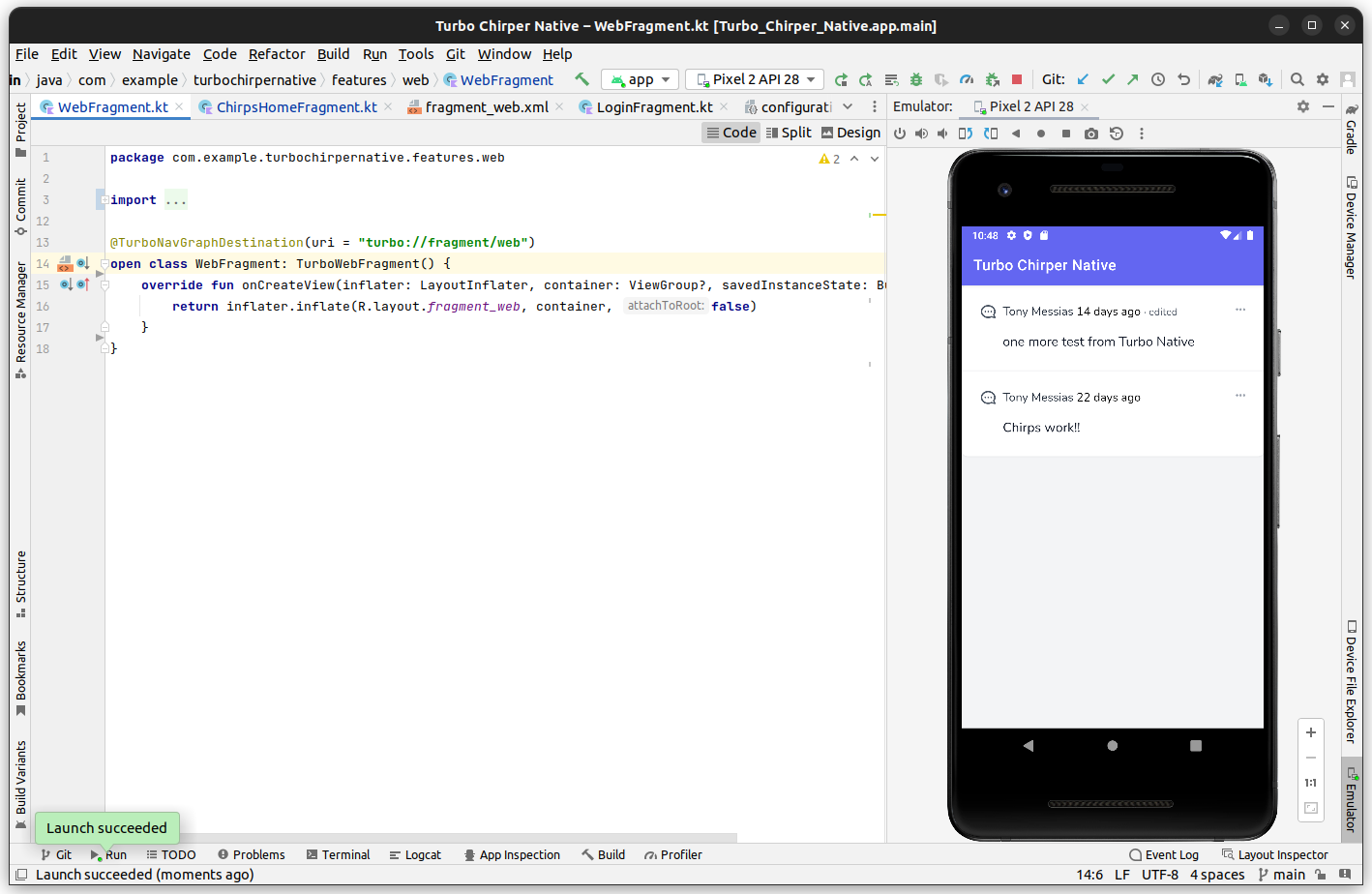
Adding the Floating Action Button
Now that the create chirps form is hidden, we need to allow our users to somehow navigate to the create chirps form. Let's create our custom ChirpsHomeFragment that will be specific to the chirps.index route.
Create a new Kotlin class inside the features.web package and call it ChirpsHomeFragment:
package com.example.turbochirpernative.features.web import android.os.Bundleimport android.view.LayoutInflaterimport android.view.Viewimport android.view.ViewGroupimport com.example.turbochirpernative.Rimport dev.hotwire.turbo.nav.TurboNavGraphDestination @TurboNavGraphDestination(uri = "turbo://fragment/chirps/index")class ChirpsHomeFragment: WebFragment() { override fun onCreateView(inflater: LayoutInflater, container: ViewGroup?, savedInstanceState: Bundle?): View? { return inflater.inflate(R.layout.fragment_chirps_home, container, false) }}Notice that we're extending the WebFragment class so we need to make it open:
package com.example.turbochirpernative.features.web import android.os.Bundleimport android.view.LayoutInflaterimport android.view.Viewimport android.view.ViewGroupimport com.example.turbochirpernative.Rimport dev.hotwire.turbo.fragments.TurboWebFragmentimport dev.hotwire.turbo.nav.TurboNavGraphDestination @TurboNavGraphDestination(uri = "turbo://fragment/web")class WebFragment: TurboWebFragment() {open class WebFragment: TurboWebFragment() {
override fun onCreateView(inflater: LayoutInflater, container: ViewGroup?, savedInstanceState: Bundle?): View? { return inflater.inflate(R.layout.fragment_web, container, false) } override fun onVisitCompleted(location: String, completedOffline: Boolean) { super.onVisitCompleted(location, completedOffline) val script = "window.NativeBridge.start();" session.webView.evaluateJavascript(script, null) } }Also, we're rendering a different layout file, so we need to create it. Add a new layout file by right-clicking on the res/layout folder and choosing the "New -> Layout Resource File" option in the menu, add the following contents to it:
<?xml version="1.0" encoding="utf-8"?><androidx.constraintlayout.widget.ConstraintLayout xmlns:android="http://schemas.android.com/apk/res/android" xmlns:app="http://schemas.android.com/apk/res-auto" xmlns:tools="http://schemas.android.com/tools" android:layout_width="match_parent" android:layout_height="match_parent"> <com.google.android.material.appbar.AppBarLayout android:id="@+id/app_bar" android:layout_width="match_parent" android:layout_height="wrap_content" android:background="?colorPrimary" app:layout_constraintEnd_toEndOf="parent" app:layout_constraintStart_toStartOf="parent" app:layout_constraintTop_toTopOf="parent"> <com.google.android.material.appbar.MaterialToolbar android:id="@+id/toolbar" android:layout_width="match_parent" app:titleTextColor="?colorOnPrimary" android:layout_height="wrap_content" /> </com.google.android.material.appbar.AppBarLayout> <include layout="@layout/turbo_view" android:layout_width="match_parent" android:layout_height="0dp" app:layout_constraintBottom_toBottomOf="parent" app:layout_constraintTop_toBottomOf="@+id/app_bar" /> <com.google.android.material.floatingactionbutton.FloatingActionButton android:id="@+id/floatingActionButton" android:layout_width="wrap_content" android:layout_height="wrap_content" android:layout_margin="16dp" android:clickable="true" android:focusable="true" android:tint="@color/white" app:tint="@color/white" app:backgroundTint="@color/indigo_500" app:layout_constraintBottom_toBottomOf="parent" app:layout_constraintEnd_toEndOf="parent" app:srcCompat="@android:drawable/ic_input_add" android:contentDescription="New Chirp" /> </androidx.constraintlayout.widget.ConstraintLayout>Now, let's register our new fragment in the MainSessionNavHostFragment:
package com.example.turbochirpernative.main import android.webkit.WebViewimport androidx.appcompat.app.AppCompatActivityimport androidx.fragment.app.Fragmentimport com.example.turbochirpernative.BuildConfig import com.example.turbochirpernative.features.auth.LoginFragmentimport com.example.turbochirpernative.features.web.ChirpsHomeFragment import com.example.turbochirpernative.features.web.WebFragment
import com.example.turbochirpernative.util.CHIRPS_HOME_URLimport dev.hotwire.turbo.config.TurboPathConfigurationimport dev.hotwire.turbo.session.TurboSessionNavHostFragmentimport kotlin.reflect.KClass class MainSessionNavHostFragment : TurboSessionNavHostFragment() {
override val sessionName = "main" override val startLocation = CHIRPS_HOME_URL override val registeredActivities: List<KClass<out AppCompatActivity>> get() = listOf() override val registeredFragments: List<KClass<out Fragment>> get() = listOf( WebFragment::class, LoginFragment::class, ChirpsHomeFragment::class, )
override val pathConfigurationLocation: TurboPathConfiguration.Location get() = TurboPathConfiguration.Location( assetFilePath = "json/configuration.json", ) override fun onSessionCreated() { super.onSessionCreated() session.webView.settings.userAgentString = customUserAgent(session.webView) if (BuildConfig.DEBUG) { session.setDebugLoggingEnabled(true) WebView.setWebContentsDebuggingEnabled(true) } } private fun customUserAgent(webView: WebView): String { return "Turbo Native Android ${webView.settings.userAgentString}" } }Now, let's configure our route path in the assets/json/configuration.json file to open that fragment whenever we visit the chirps.index route:
{ "settings": { "screenshots_enabled": true }, "rules": [ { "patterns": [ ".*" ], "properties": { "context": "default", "uri": "turbo://fragment/web", "pull_to_refresh_enabled": true } }, { "patterns": [ "login$", "login/$" ], "properties": { "context": "default", "uri": "turbo://fragment/auth/login", "pull_to_refresh_enabled": false } }, { "patterns": [ "chirps$", "chirps/$" ], "properties": { "context": "default", "uri": "turbo://fragment/chirps/index", "pull_to_refresh_enabled": true } } ]}Notice that the URI matches what we defined in the ChirpsHomeFragment: turbo://fragment/chirps/index.
At this point, our app looks like this:
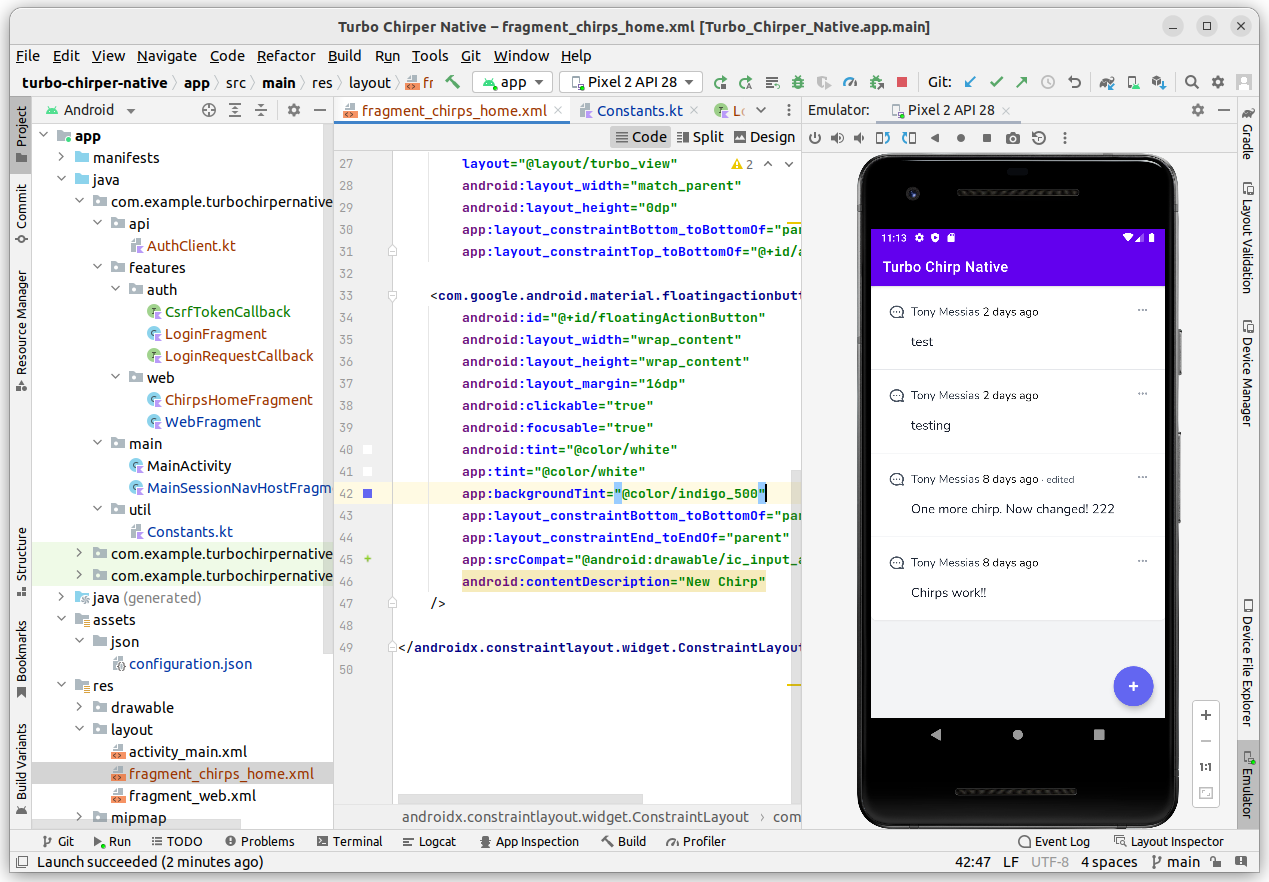
But our button doesn't work yet. Let's tell Turbo Native to make a visit to the chirps/create route. First, add the new constant to the util.Constants file:
package com.example.turbochirpernative.util const val BASE_URL = "http://10.0.2.2"const val CHIRPS_HOME_URL = "$BASE_URL/chirps"const val CHIRPS_CREATE_URL = "$CHIRPS_HOME_URL/create" const val API_BASE_URL = "$BASE_URL/api"const val API_CSRF_COOKIES_URL = "$BASE_URL/sanctum/csrf-cookie"const val API_LOGIN_URL = "$API_BASE_URL/login"Now, change the ChirpsHomeFragment to setup the click handler on that fab:
package com.example.turbochirpernative.features.web import android.os.Bundleimport android.view.LayoutInflaterimport android.view.View import android.view.ViewGroupimport com.example.turbochirpernative.Rimport com.example.turbochirpernative.util.CHIRPS_CREATE_URLimport com.google.android.material.floatingactionbutton.FloatingActionButtonimport dev.hotwire.turbo.nav.TurboNavGraphDestination @TurboNavGraphDestination(uri = "turbo://fragment/chirps/index")class ChirpsHomeFragment: WebFragment() {
override fun onCreateView(inflater: LayoutInflater, container: ViewGroup?, savedInstanceState: Bundle?): View? { return inflater.inflate(R.layout.fragment_chirps_home, container, false) } override fun onViewCreated(view: View, savedInstanceState: Bundle?) { super.onViewCreated(view, savedInstanceState) setupFab() } private fun setupFab() { view?.findViewById<FloatingActionButton>(R.id.createChirpsFab)?.setOnClickListener { navigate(CHIRPS_CREATE_URL) } } }Now, let's click on it and you should be redirected to the create chirps form! How cool is that?!
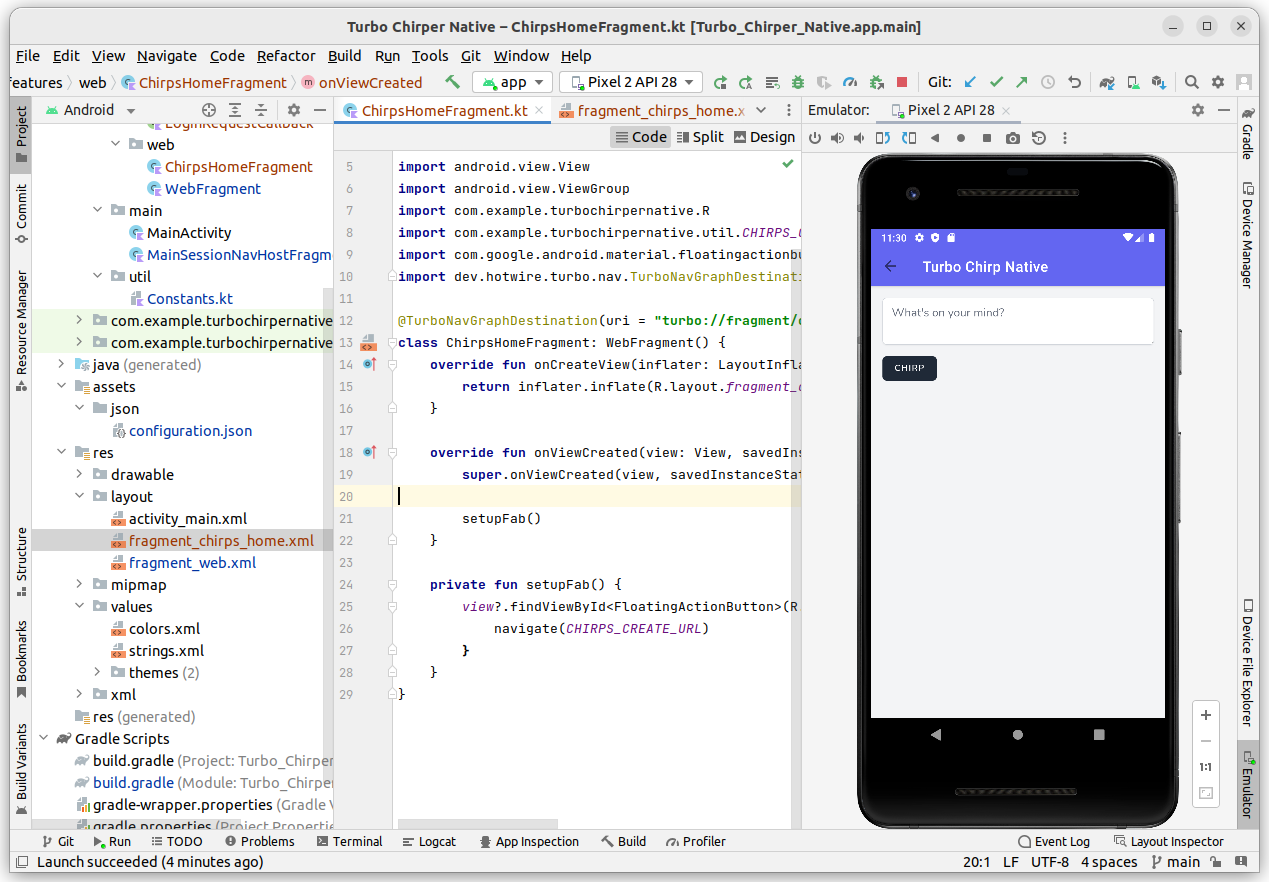
If you try creating a chirp, however, you should see some interesting behavior...
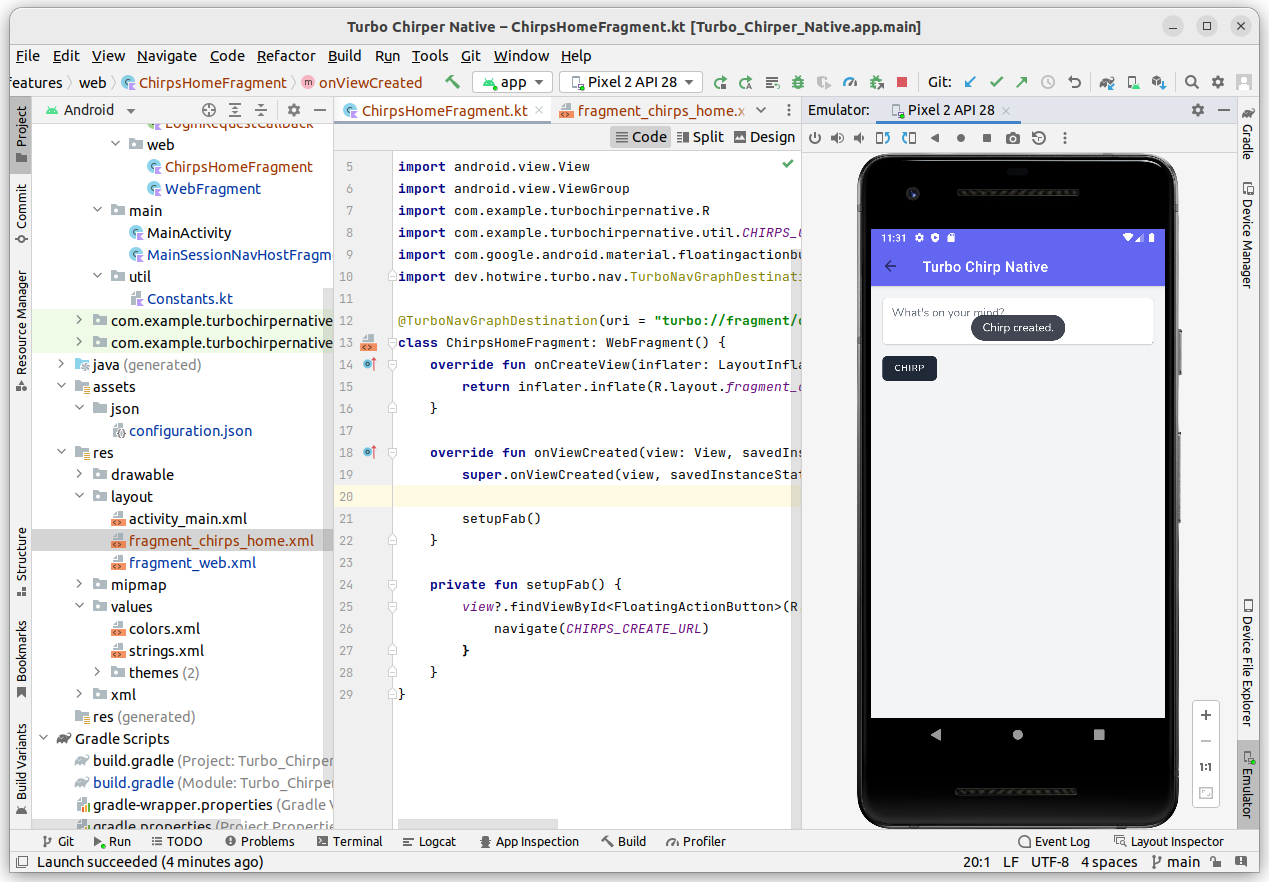
That's not good. That's because we're returning Turbo Streams on the ChirpController@store action. Let's change it so it doesn't do that when the request was done via a Turbo Native client. We want the redirect there. Head to the app/Http/Controllers/ChirpController.php file and change the store action like so:
<?php
namespace App\Http\Controllers; use App\Models\Chirp;use Illuminate\Http\Request; class ChirpController extends Controller{
/** * Display a listing of the resource. * * @return \Illuminate\Http\Response */ public function index() { return view('chirps.index', [ 'chirps' => Chirp::with('user:id,name')->latest()->get(), ]); } /** * Show the form for creating a new resource. * * @return \Illuminate\Http\Response */ public function create() { return view('chirps.create'); } /** * Store a newly created resource in storage. * * @param \Illuminate\Http\Request $request * @return \Illuminate\Http\Response */ public function store(Request $request) { $validated = $request->validate([ 'message' => ['required', 'string', 'max:255'], ]); $chirp = $request->user()->chirps()->create($validated); if ($request->wantsTurboStream()) { if ($request->wantsTurboStream() && ! $request->wasFromTurboNative()) { return turbo_stream([ turbo_stream($chirp, 'prepend'), turbo_stream()->update('create_chirp', view('chirps._form')), turbo_stream()->append('notifications', view('layouts.notification', [ 'message' => __('Chirp created.'), ])) ]); } return redirect() ->route('chirps.index') ->with('status', __('Chirp created.')); }
/** * Display the specified resource. * * @param \App\Models\Chirp $chirp * @return \Illuminate\Http\Response */ public function show(Chirp $chirp) { // } /** * Show the form for editing the specified resource. * * @param \App\Models\Chirp $chirp * @return \Illuminate\Http\Response */ public function edit(Chirp $chirp) { $this->authorize('update', $chirp); return view('chirps.edit', [ 'chirp' => $chirp, ]); } /** * Update the specified resource in storage. * * @param \Illuminate\Http\Request $request * @param \App\Models\Chirp $chirp * @return \Illuminate\Http\Response */ public function update(Request $request, Chirp $chirp) { $this->authorize('update', $chirp); $validated = $request->validate([ 'message' => ['required', 'string', 'max:255'], ]); $chirp->update($validated); if ($request->wantsTurboStream()) { return turbo_stream([ turbo_stream($chirp), turbo_stream()->append('notifications', view('layouts.notification', [ 'message' => __('Chirp updated.'), ])), ]); } return redirect() ->route('chirps.index') ->with('status', __('Chirp updated.')); } /** * Remove the specified resource from storage. * * @param \Illuminate\Http\Request $request * @param \App\Models\Chirp $chirp * @return \Illuminate\Http\Response */ public function destroy(Request $request, Chirp $chirp) { $this->authorize('delete', $chirp); $chirp->delete(); if ($request->wantsTurboStream()) { return turbo_stream([ turbo_stream($chirp), turbo_stream()->append('notifications', view('layouts.notification', [ 'message' => __('Chirp deleted.'), ])), ]); } return redirect() ->route('chirps.index') ->with('status', __('Chirp deleted.')); } }This should redirect us to the home page after creating a chirp and the new Chirp should appear there! Cool.
We have lost the flash message, but we'll handle that soon. One thing is bothering me: we're showing the "Turbo Chirper Native" title on every screen. I don't like that. Instead, I want each screen to customize the title. Well, it turns out it already does that based on the title of the page we're visiting. Let's change our app.blade.php layout file to accept a $title prop:
<!DOCTYPE html><html lang="{{ str_replace('_', '-', app()->getLocale()) }}"> <head>
<meta charset="utf-8"> <meta name="viewport" content="width=device-width, initial-scale=1"> <meta name="csrf-token" content="{{ csrf_token() }}"> <title>{{ config('app.name', 'Laravel') }}</title> <title>{{ $title ?? config('app.name', 'Laravel') }}</title>
<!-- Fonts --> <link rel="stylesheet" href="https://fonts.bunny.net/css2?family=Nunito:wght@400;600;700&display=swap"> <!-- Scripts --> @vite(['resources/css/app.css', 'resources/js/app.js']) </head>
<body class="font-sans antialiased"> <div class="min-h-screen bg-gray-100"> @include('layouts.partials.navigation') @include('layouts.partials.notifications') <!-- Page Heading --> <header class="bg-white shadow turbo-native:hidden"> <div class="max-w-7xl mx-auto py-6 px-4 sm:px-6 lg:px-8"> {{ $header }} </div> </header> <!-- Page Content --> <main> {{ $slot }} </main> </div> </body> </html>Now, let's register the prop in the AppLayout component in app/View/Components:
<?php
namespace App\View\Components; use Illuminate\View\Component; class AppLayout extends Component{ public function __construct(public ?string $title = null) { }
/** * Get the view / contents that represents the component. * * @return \Illuminate\View\View */ public function render() { return view('layouts.app'); } }Then, in the resources/views/chirps/create.blade.php file, set the :title prop in the <x-app-layout> component:
<x-app-layout><x-app-layout :title="__('Create Chirp')">
<x-slot name="header"> <h2 class="font-semibold text-xl text-gray-800 leading-tight"> <a href="{{ route('chirps.index') }}" class="underline underline-offset-2 text-indigo-600">Chirps</a> <span class="text-gray-300">/</span> {{ __('New Chirp') }} </h2> </x-slot> <div class="max-w-2xl mx-auto p-4 sm:p-6 lg:p-8"> <x-turbo::frame id="create_chirp" target="_top"> @include('chirps._form') </x-turbo::frame> </div> </x-app-layout>And with that, our create chirps page should have the "Create Chirp" title:
